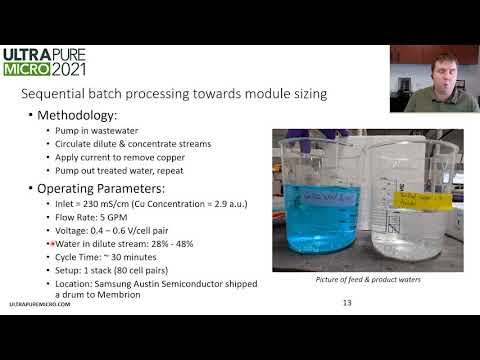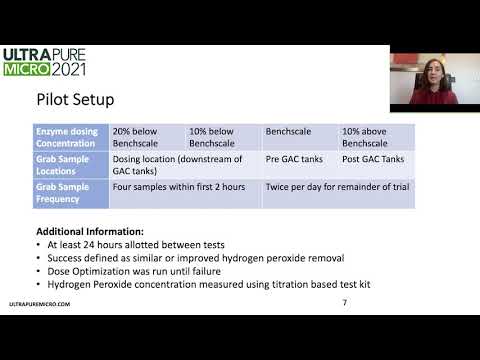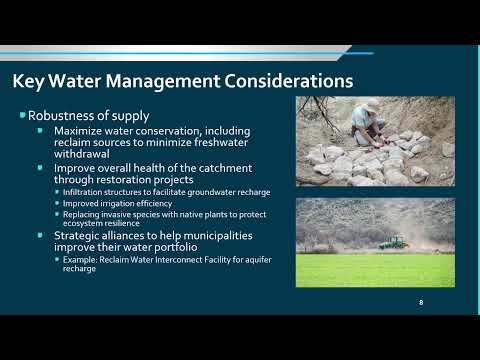
Orla McCoy
Global Water Intelligence
Collaborators
Tags
Water ConservationEnergy ConservationWater circularity in semiconductor facilities: three key themes
Insights from Victoria Yun, Senior Project Engineer at Samsung Austin Semiconductor, and Deena Starkel, Principal Water Engineer at Micron Technology, from the Global Water Summit 2022
Share this insight
1. Challenges posed by UPW quality requirements can be offset by other reuse avenues The semiconductor manufacturing process demands huge quantities of ultrapure water (UPW), but the extremely strict UPW quality parameters are a major consideration when adjusting operational methods for recycling water.
Victoria Yun explained that reclamation of the UPW rinse stream has seen success at Samsung Austin Semiconductor (SAS) in Austin, Texas, as water can be collected from the stream, monitored for quality, treated with activated carbon and ion exchange, and then returned to the start of the UPW treatment process as makeup water. Although UPW quality requirements limit recycling potential to the UPW treatment system, other reuse possibilities are available. For example, SAS reuse water by reclaiming second pass reverse osmosis (RO) or ultrafiltration reject for feeding scrubbed exhaust systems, boilers and other onsite applications. Deena Starkel also explained that the Micron facilities team in Boisie, Idaho, recycles relatively uncontaminated rinse water for wafer processing. Other streams are also recycled, such as RO reject which can be reused in applications which don’t have the same purity requirements as UPW. Because of this reuse opportunity, optimizing water recovery from RO units is an ongoing priority.
2. Water circularity methods are connected to chemical and energy usage Water and wastewater management facilities teams also consider chemical and energy consumption when choosing treatment options.
For example, Starkel said that the high volume of chemicals needed in semiconductor manufacturing can make wastewater streams complex. Methods which separate chemicals out of wastewater streams have a twofold benefit: they can make the stream easier to treat and offer opportunities to sell reclaimed chemicals to other industries.
Starkel also elaborated on considerations related to energy consumption. As semiconductor discharge water is relatively clean, the major consideration is about how much energy to use to treat contaminants and recovery water. The focus for engineers is determining the right balance between meeting net-zero carbon goals and net-zero water consumption goals.
Yun shared that Samsung Austin Semiconductor engineers are piloting a technique to reduce the carbon footprint associated with collecting and transporting wastewater for off-site treatment. Collaboration with an innovative start-up led to the project, wherein electrodialysis reversal (EDR) is enhanced by ceramic membranes to maximize wastewater stream concentration, and thereby divert the permeate to dilute wastewater treatment. Pilot results were successful for reducing the volume of wastewater which would need to be trucked, and there were promising results for the treatment of the permeate within the on-site reuse parameters.
3. Collaboration can be key to improving water circularity Knowledge-sharing on several levels can be useful for improving water circularity:
- Collaboration between teams at semiconductor fabs instills passion about water reuse, reduction and recycling. Yun explained that engagement between the facilities teams and process teams is key to convey information about water usage and lifecycle for the site. Starkel advocates to instill understanding in technicians about the importance of recycling and reuse of water to promote new ideas for operational improvement.
- Collaboration between chip manufacturers can help drive water circularity. Data-sharing can bring about the implementation of innovative technologies for water treatment, as results can be observed without relying on onsite pilots that can directly impact the product.
- Collaboration between different industries can be mutually beneficial. Although the semiconductor fabrication process is unique for each chip manufacturer, water reuse and recycle methods are often similar across industries and are less likely to consist of sensitive, proprietary information.
Share this insight
Related insights
5 trends from the UPM 2023 Environmental Sustainability Panel

Orla McCoy
Global Water Intelligence
Intel Water Usage: Chart

Orla McCoy
Global Water Intelligence
Digital transformation: opportunities and challenges for the semiconductor industry

Georgia Bottomley
Global Water Intelligence
Related resources

Electrodialysis reversal enhanced by ceramic membranes for recycling of copper wastewater

Hydrogen Peroxide (H2O2) removal - GAC or enzyme approach

Streamlining Data Driven Decisions to Support Facility 2.0 Needs
